Best Home Rowing Machine - Buyer's Guide
➤ Best Home Rowing Machine ⭐ If you want to stay fit and healthy or become fit again, you can’t avoid regular exercise. Regardless of the weather and the opening times of a fitness studio, home training equipment is ideal for this. In addition to bicycle ergometers, cross trainers, and treadmills, rowing machines are very popular.
The so-called indoor rowing is suitable for beginners and advanced users of all ages strengthening the cardiovascular system and a variety of muscles, improving lung capacity, and endurance, and helping to lose weight. The following rowing machine comparison presents some popular devices and provides assistance in choosing the best device for personal requirements.
BEST OF THE BEST
Mr. Captain Rowing Machine
PROS
A great number of functions including BlueTooth connectivity, 50 plus global routes on LCD display, and 25 levels of resistance are the main strengths of this machine built to last over time.
CONS
The heart rate sensor can at times be inaccurate.
CONCLUSION
The Schwinn Fitness 470 Elliptical proves to be an ideal object to start this sporting practice. Thanks to a manual adjustment of the effort and a clear display, it allows you to keep various parameters under observation.
RUNNER UP
JKANGFIT Folding Rowing Machine
PROS
The Elliptical Machine is very easy to install, equipped with big pedals making it easy to exercise for the whole family. No disturbing to others as it comes with a magnetic system that eliminates noise.
CONS
The machine doesn't have a cup holder and the foot pedals are a bit narrow.
CONCLUSION
The Niceday Elliptical Machine is a great choice for an elliptical machine that comes with great features without spending a fortune. It's a great machine for a decent price and it's very easy to assemble, as most of it comes pre-assembled. The most quiet elliptical machine that doesn't need electricity.
BUDGET PICK
Stamina Hydraulic Rowing Machine
PROS
The structure is essential and does not take up excessive space but, despite this, it does not lack all the essential elements for satisfactory training aimed at improving the health of one's body.
CONS
Based on customers the machine can be a bit noisy
CONCLUSION
An elliptical with a satisfactory relationship between price, performance, and overall quality. Of course, it is a low-cost model, so expectations must be equated with the economic outlay.
What Is A Rowing Machine?
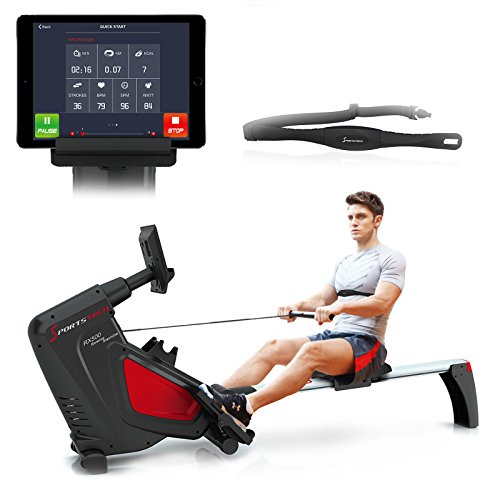
Rowing machines mimic the motion of rowing a boat on the water. They consist of a stretcher/footboard for putting your feet down, a movable seat, and a pulley that the exerciser pulls towards you. Alternatively, there are rowing machines with outriggers, with an outrigger simulating the boat paddle in the outrigger technique. The so-called ergo rowing trains the upper body and lower body, especially the back, shoulders, arms, and legs. The resistance of a rowing machine is generated either hydraulically, (electro)magnetically, by air or water resistance.
Training and building muscles with the rowing machine are very efficient since 85 percent of the body’s muscles are involved in the training.
Rowing machines that have a power measurement or display in watts are called rowing ergometers. They are more likely to be found in the professional sector.
How Do Rowing Machines Work?
If you are looking for the right device for training at home, you can choose from sports equipment such as cross trainers, ergometers, treadmills, and rowing machines. While only certain areas are trained with the cross trainer or ergometer, training on the rowing machine with the appropriate rowing technique is very efficient and effective. Endurance and coordination can be trained and muscles can be built up. Losing weight could be another reason for getting a rowing machine.
There is a wide range of rowing machines on offer and there are various models in every price range. Basically, rowing machines have a seat that runs on two rails. During training, the trainee sits on the rowing seat and puts his feet on the pedals provided. Before you start, your feet must be fixed with the straps provided for this purpose in order to have a stable hold during training.
If it is a rowing machine with a cable system, the rowing handle must be pulled firmly against the upper body with both hands when using the cable system. Due to the resistance in the rowing machine, the pulling system requires different amounts of muscle power, depending on the setting.
On a rowing machine with outriggers, instead of a cable pull with a handle, there are two levers that are modeled on paddling a rowing boat. The typical rudder movement in the cantilever system is caused by the forward and backward movement on the rail.
Are Rowing Machines Useful?
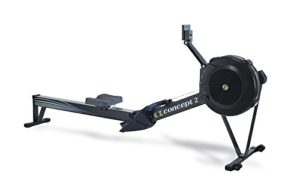
Rowing machines are considered to be the most efficient home trainers of all. This is because rowing uses more muscle groups than any other exercise bike. Therefore, rowing machines can be used in many ways.
Depending on the resistance setting, the user uses the rowing machine not only to train their condition but also to do intensive strength training. The rowing movement also challenges the abdominal muscles – if you work hard, you can train a six-pack. Indoor rowing is also an effective way of reducing stress.
Endurance training with a rowing machine has a positive effect on fitness and the ability to concentrate. The improved endurance also strengthens the cardiovascular system.
A one-hour rowing workout burns an average of around 630 kilocalories. If you want to lose weight, you can achieve enormous success with the rowing machine with continuous training. Since rowing is also easy on the joints or splashing on the water reduces the stress on the joints, it is much more suitable for overweight people than jogging or cycling.
What Rowing Machines Are There?
Rowing machines can be divided into two groups according to their basic construction:
- Rowing machines with cable pull
- Outrigger rowing machines
Both alternatives have their advantages and disadvantages. While the cable models are easier to use, the cantilever models require some getting used to and coordination, as both arms must be pulled synchronously and with equal amounts of force. Rowing machines with outriggers also take up more space. In most cases, they are equipped with a hydraulic braking system.
Rowing machines with outriggers are less suitable for beginners, they are more intended for professional training and ideal for those who have experience with real rowing on the water.
Another distinguishing feature of rowing machines is the type of resistance system:
- Rowing machines with air resistance:
Rowing creates air turbulence, which the rowing machine works against. This type of rowing machine comes closest to real rowing, which is one of the endurance sports. Air resistance increases as the number of strokes increases. - Rowing machines with water resistance:
With the rowing machines with water resistance, the home trainer works with water turbulence. The amount of water that you fill into the container on the rowing machine is decisive. The basic resistance changes depending on the amount of water. - Rowing machines with magnetic braking systems:
With these rowing machines, the resistance is determined by the distance between a magnet and the flywheel. The device works without friction. The setting is flexible, for example manually or – somewhat easier and more convenient – via the onboard computer of the rowing machine. - Rowing machines with hydraulic resistance:
The simplest and cheapest variant – like the shock absorber in a car, an oil-filled cylinder brakes the movements to a greater or lesser extent depending on the resistance set. A disadvantage of hydraulic rowing machines: The hydraulic cylinder is subject to a certain amount of wear. In addition, the movement is less fluid. - Rowing machines with multiple functions:
Some manufacturers offer rowing machines with several additional functions, which can be used not only for rowing but also as a training device for targeted biceps training or as a recumbent ergometer.
Rowing Machines - Are They Really Effective?
Of course, in addition to the rowing machine, there are other training devices that help to build up stamina, lose weight or keep fit. However, the rowing machine is one of the most effective training devices because it involves so many parts of the body and muscles. In addition, rowing in general – whether with a rowing machine or a real rowing boat – is one of the healthiest sports.
According to doctors, 60 percent of the maximum pulse value is reached within a very short time. Rowing represents an optimal mixture of endurance and muscle training. According to doctors, new nerve cells are formed when rowing, which means that our brain becomes more receptive.
Rowing is equally suitable for women and men. The risk of injury on a rowing machine is low compared to other sports equipment. Compared to jogging or playing football, it is much easier on the joints.
Which Muscles Does A Rowing Machine Train?
As mentioned elsewhere in this guide, a rowing machine allows for an exceptionally varied workout. Up to 80 percent of the muscles are trained, with the back and leg muscles being particularly important. The following overview of all muscles that are taken into account when training with a rowing machine speaks for itself:
- Abdominal muscles
- Flexor muscles in the fingers
- Biceps
- Glutes
- Large back muscle
- Back shoulder
- Back extensors
- Trapezius muscle and neck
- Forearm muscles
- Front and back thighs
- Calves
The Pros And Cons Of The Rowing Machines
In the following overview, we have summarized briefly and concisely which arguments speak in favor of buying a rowing machine and which speak against it.
Pros
- Up to 85 percent of all muscles are trained with a rowing machine
- Effective endurance training, strength training and weight loss possible
- Good for the cardiovascular system, prevents obesity
- Strengthening of the back muscles and abdominal muscles as well as the immune system
- Training at home in any weather
- Never again be dependent on the opening hours of the gym
Cons
- Partly high purchase costs
- Additional space required in the apartment
Guide To Buying A Rowing Machine
Keep fit, train, and resume physical activity after an injury. Whatever your needs are, with a rowing machine you will have a very useful tool to take care of your body.
In order not to make a bad purchase with the variety of models that the market offers, you should familiarize yourself with the most important comparison criteria in advance. The following points can serve as a guide for creating your own checklist:
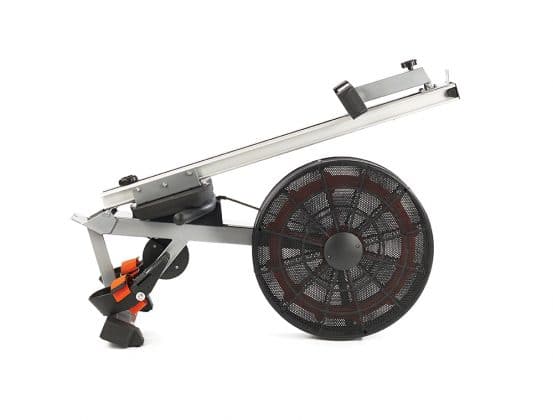
Traction Makes The Difference
The main feature that differentiates the rowing machines on the market, both the cheap ones and those of the best brands, is the traction. There are two types: Scandinavian (or Latin) and Central. The choice differs according to your needs and the type of training you want to perform.
The Scandinavian traction is the one that best reproduces the typical movements of rowing and is, therefore, the one to prefer if you want to train for this type of sporting activity. It is characterized by the presence of two separate arms in order to replicate the movement of the row as closely as possible. It is a model designed for the more experienced and therefore requires a certain mastery to perform the movement correctly.
As the name suggests, however, the central traction revolves around the use of a single-arm, acting on which both the arms and the rest of the body are worked effectively. This is because the rowing movement obtained is symmetrical, fluid, and easier to perform so as to ensure comfort and effectiveness.
Body Height And Body Weight
The body size and weight of the person exercising are of decisive importance for the selection of the right rowing machine. Larger, heavier people sometimes find a narrow seat too uncomfortable, and if the seat rail does not reach far enough, the athlete cannot perform a smooth rowing movement. In addition, attention should be paid to the maximum permissible weight that is specified in the respective product description.
Dimensions Of The Rowing Machine
If you live in a small apartment, you should measure more precisely how much space the fitness device takes up when assembled before purchasing an indoor rower. Many rowing machines can be folded up when not in use and stowed away to save space – be sure to clarify before buying!
Seat Of The Rowing Machine
To ensure that rowing does not become uncomfortable or even painful over longer training sessions, the seat should provide good support, be ergonomically shaped, not too narrow, and sufficiently padded.
Seat Of The Rowing Machine
To ensure that rowing does not become uncomfortable or even painful over longer training sessions, the seat should provide good support, be ergonomically shaped, not too narrow and sufficiently padded.
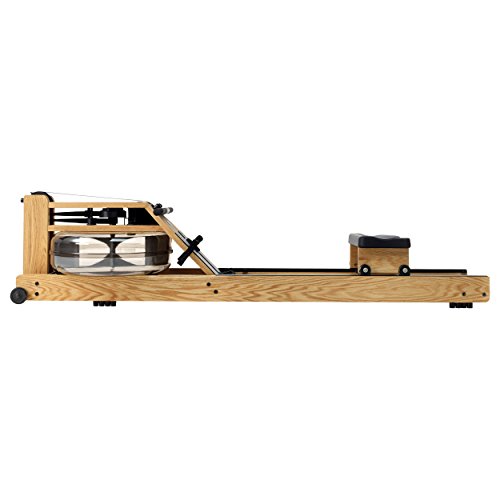
Possible Adjustments
The comparison between the prices of the rowing machines for sale also involves the choice of the mechanism that regulates the resistance, or the method that the machine uses to allow you to increase or decrease the effort necessary to complete the movement.
The models with mechanical adjustment allow you to turn a knob to increase or not the friction of a magnet on a flywheel, so as to make the rowing more or less demanding. Those with air regulation, on the other hand, exploit the level of air present in a piston: the more there is, the greater the force necessary to perform the rowing.
In this second case, the advantage is represented by a practically infinite number of resistance levels while the main cons are constituted by an average selling price higher than mechanical rowers.
A Hi-Tech Touch
Another discriminant of choice is represented by the availability of technologically more advanced functionalities. The presence of a display on which to view information relating to training (speed, distance traveled, calories burned, the time elapsed) is now a standard.
There are more essential rowers, which aim to make you save on the selling price, and others more expensive and advanced that also use the screen to offer you a series of predefined workouts, ideal for obtaining a certain type of results.
If you want something more, you can opt for a rowing machine with a heart rate detector, using a band that, depending on the model, may already be present in the package or simply provided as an accessory to be purchased separately.
How To Use The Rowing Machine
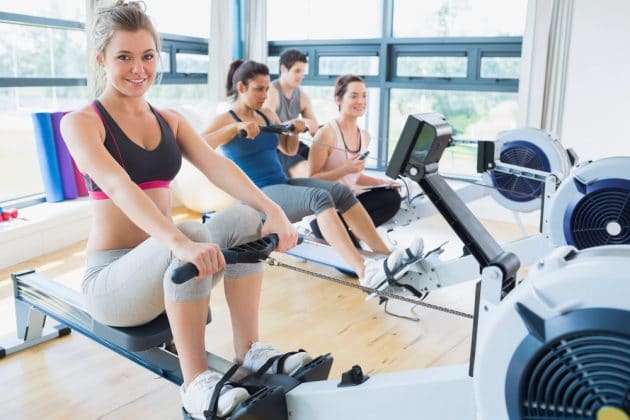
If you don’t like the gym and prefer to work out at home, the rowing machine can be a useful tool to take care of you. In fact, he manages to make the whole bodywork well, allowing you to maintain a good physical shape. Do you have doubts about the model to choose and its use? Consult our guide, which can give you useful information on how to make your decision.
In the starting position, the hips, knees, and ankles are bent, the lower legs are perpendicular to the footrests, while the chest almost touches the thighs; the arms are stretched. The rowing stroke begins by stretching the legs while simultaneously pulling on the handle.
During the leg kick, the shoulders and torso move back into the supine position. The arms are bent from the height of the knees. The legs are now stretched, but the knees should not be fully locked, but remain slightly bent. While the seat now slides forward on the rail, the body straightens up again in the end position. This sequence of movements is repeated as often as desired.
It is important to pay attention to the right load during rowing training. With the right intensity, the athlete can easily hold out and train on the rowing machine for about 45 minutes. If you can manage it, you should row at least twice a week.
How To Adjust It
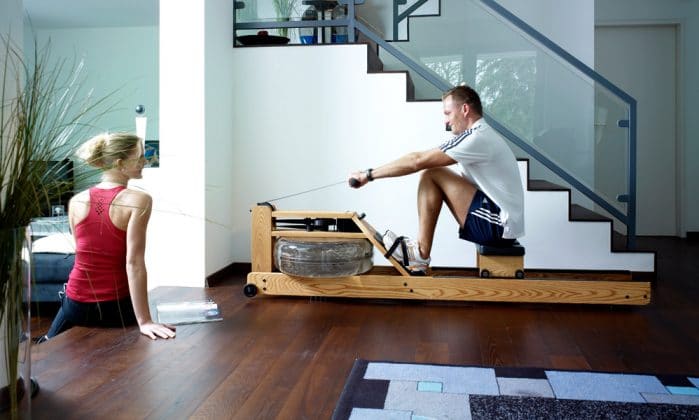
Each rowing machine is equipped with a system that allows you to adjust its resistance. This aspect is of fundamental importance if you intend to increase the effort made during training, to improve the results obtained.
Models with mechanical adjustment are equipped with a wheel that you just need to tighten to increase or decrease the friction of a magnet on the flywheel. The cost of such a rowing machine is quite low but the limit lies in not being able to push beyond the maximum tension imposed by this mechanism.
The air regulation, on the other hand, takes advantage of the level of air present in a piston: the more there is, the more force you will have to put into performing the movement. The price will increase but also the possibility of having one more obstacle to overcome, from time to time, without having to switch to a tool with greater resistance.
The Dimensions And The Material
A compact rowing machine can also be stored in a corner of your room, without occupying the place intended for other objects. If you want to move it often, take into account the material, which must be resistant and withstand constant travel.
Metal is better than wood, even if the latter has a certain aesthetic impact that is difficult to match.
How Often Should I Use The Rowing Machine?
As with all sports and training equipment, the following applies to the rowing machine: regularity is the be-all and end-all of training success. If the training goal is to build up stamina and muscles, this should be pursued consistently in the form of training several times a week. However, experienced athletes and sports physicians advise against daily training on the rowing trainer.
Which Is Better - Treadmill Or Rowing Machine?
Both training devices offer an intensive strain on the muscles and can support weight loss. Everyone has to decide for themselves which device is better for their personal use. Those who enjoy running will prefer the treadmill, while rowing enthusiasts will opt for the rowing machine. If you want to tackle a full-body workout, the rowing machine is the better choice.
Which Accessories Are Useful For Rowing?
A chest strap is useful for heart rate measurement, which is not included with all rowing machines. The manufacturers usually indicate which chest strap is compatible with their rowing machine or supply it for an additional charge. Depending on the surface on which the rowing machine is to be set up, a floor protection mat is recommended. It has a noise-insulating effect and protects the floor from damage.
What Is Interval Training?
Advanced users with good stamina can access interval training on the rowing machine at home or in the office. There is an alternating stronger and weaker rowing phase. The weaker rowing phase of interval training is a restful break. This isn’t really a pause, rather the intensity of the strokes is reduced during the restful pause in interval training. Rowing is done at different levels of intensity. Interval training allows the anaerobic metabolism to be trained well. This ensures endurance training for short-term very high loads.
FAQ
In order to find out which is the best rowing machine for you personally, you should be as clear as possible about your own wishes and requirements for such a machine. An excellent device for professionals is not necessarily the best choice for beginners – and vice versa. Solid workmanship, as many resistance levels as possible, and that the device fits your body size and weight are important. The comparison factors listed in this guide can be used to narrow down the selection to models that suit your own needs.
Rowing machines are available for around 100 dollars, with almost no upper price limit. In general, the more professional the sports equipment, the higher the price. When buying the rowing machine, the buyer should consider what is important to him and what budget is available to him. It doesn’t have to be the most expensive model on the market, especially for beginners. It’s worth comparing prices.
Which rowing machines are suitable for home use depends on how much space is available. Before buying, the dimensions of interesting models should be carefully compared so that there is no unpleasant surprise. A rowing machine for the home does not necessarily have to be of studio quality. However, it should still be robust and cleanly processed so that you can enjoy it for as long as possible.
Depending on the intensity of the rowing training, up to 1,000 calories can be burned per hour. However, beginners in particular should not train with excessive resistance and avoid peak loads with a high heart rate. Here, too, it is better to steel yourself with a lower pulse (maximum 180 minus your age) and a few minutes longer.
Since rowing is a full-body workout, a rowing machine is great for losing weight. More calories are burned than with other fitness equipment that trains fewer different muscle groups. As always, self-discipline is important. In addition, the rowing machine should be used regularly in order to achieve success.
In the beginning, it is important when rowing to execute the movement correctly. Impact numbers or train movements initially play a subordinate role. Depending on the selected level of difficulty or training, the number of beats should be around 24 to 30 beats per minute.
Disclosure: There are affiliate links in this comparison. If you click on one of the product links and buy a product, we will receive a commission for this. However, there are no additional costs for you. Thanks a lot for this! Learn More



